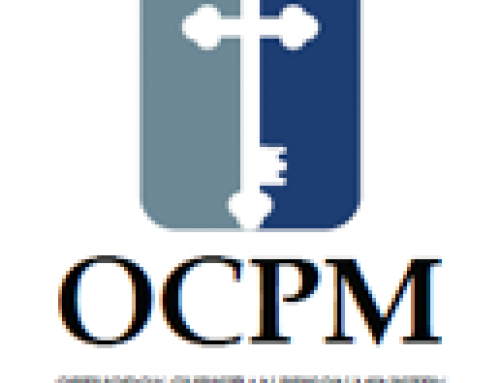This post was originally published on this site
Introduction
St. Dionysius the Areopagite is often perceived as one of the more difficult Church Fathers to read and comprehend. His writing style and the ideas he presents can be complex, and at the same time, his influence is felt across generations of later Church Fathers. He’s referenced and revered by the likes of St. John of Damascus, St. Maximos the Confessor, St. Cyril the Enlightener of the Slavs, and St. Theodore the Studite. St. Dionysios teaches us about many things—about the centrality of the sacraments to the life of the Church, about the responsibilities of clergy, monks, and lay people to one another, and about how we can talk about God, both cataphatically (who He is) and apophatically (who He is not).
Today’s discussion will focus on three paradoxes or seemingly contradictory things that St. Dionysios employs to teach us about God, the world, and ourselves. We’ve summarized his teachings for you while trying not to oversimplify them or lose the poetic manner of expression he employs. We encourage you to take your time reading and contemplating each reflection.
Before we begin our discussion, let’s begin with 120 seconds of silence. It’s been a long day.
Take this chance to come into the presence of God and his saints as a group. Sit still. Breathe slowly and deeply. Say the Jesus prayer.
Part I: All & Nothing
Reflection
God is the cause of all things while being outside of all things, and it is in His ecstatic movement outside of Himself that things come to be. God the Trinity goes outside of Himself to create, and so all creation is outside of and apart from God. And yet, in creating, God imbues all things with Himself in a manner proper to their purpose, their logos. All things thus are intended to reveal God while never encompassing or defining Him. God is the Being of beings who is Himself beyond Being.
He “neither was, nor will be, nor came to be nor comes to be, nor will come to be; indeed, he is not; but he is being to beings…” – On the Divine Names 5.8
Likewise, He is the life of the living, the wisdom of the wise; He is the cause of every feature of everything. Famously, Dionysios tell us that
“God is all in all and nothing in any.” – On the Divine Names 7.3
Therefore, we might say that our very purpose is to symbolize God, to reflect the One Who Is. Because while the One remains in Himself as He creates outside Himself, creation is truly imbued with god-likeness to the degree appropriate to each created thing, and in the very same movement, the many things of creation are drawn up into the One through their symbolic nature. So He is the life of the living and all that is living participates in the Life of God; He is the wisdom of the wise, and that which is wise participates in the Wisdom of God. Everything becomes symbols or images of God in a manner appropriate to their being.
“The very order of the visible universe sets forth the invisible things of Almighty God…” – Epistle 9.2
The entire created order is an unfolding theophany, a revelation of God, and yet God is like nothing in the world. The sensible world, the angelic orders, the words of Scripture, the hierarchy of the Church, the sacraments—all by their very nature point towards the Creator and make Him known. Even that which seems in opposition to God reflects Him in that it shows us what He is not.
“The Evil then is privation and failure, and want of strength, and want of proportion, and want of attainment, and want of purpose; and without beauty, and without life, and without mind, and without reason, and without completeness, and without stability, and without cause, and without limit, and without production; and inactive, and without result, and disordered, and dissimilar, and limitless, and dark, and unessential, and being itself nothing in any manner of way whatever.” – On the Divine Names 4.21
Evil is meontic or “without being” in of itself. And yet, because of its very lack, it paradoxically points us back to true being and to the Supraessential One, God who is also “without being” or rather, who is beyond being.
Discussion Questions
- How does the paradox between God’s presence in all things and the fact that nothing encompasses or defines God respond to common misconceptions about God?
- How does the understanding of all of creation as theophany validate or challenge your view of the world around you?
- What does it mean for everything to reflect God “in a manner appropriate to their being”? Can you come up with some examples?
- How would you apply Dionysios’ understanding of evil as having no substance to the evil you see in the world around you and within yourself?
Part II: Revealed & Hidden
Reflection
If God is all in all and nothing in any, Dionysios tells us, then the manner in which God reveals Himself is hidden rather than direct. We come to know God not by seeing His face, but through the symbolic world around us. Dionysios sees in the Scriptures and in the Liturgy continuity with the God-revealing creation. For instance, in Scripture, sensible images are used to describe God and the angels because the sensible realm is the realm of divine disclosure to us, the means by which theophany can occur.
“For it is not possible for our mind to be raised to that immaterial representation and contemplation of the Heavenly Hierarchies, without using the material guidance suitable to itself, accounting the visible beauties as reflections of the invisible comeliness […] things [which] were transmitted to Heavenly Beings supermundanely, but to us symbolically.” – On the Celestial Hierarchy 1.3
According to Dionysios, God and the immaterial angelic orders must be described in the Scriptures and depicted by the Church as having form because, at least initially, we can only come into contact with the bodiless beings through symbols. While the images of Scripture, for Dionysios, are a means of divine knowledge, they are not simply didactic, and they do more than just depict historical events for one’s edification and comprehension of Biblical and ecclesiastical events. In fact, images are important largely because they are enigmatic—hiding the mysteries of God in their very revelation of Him:
The cause why forms are naturally attributed to the formless, and shapes to the shapeless, is not alone our capacity which is unable immediately to elevate itself to the intelligible contemplations, and that it needs appropriate and cognate instructions which present images, suitable to us, of the formless and supernatural objects of contemplation; but further, that it is most agreeable to the revealing Oracles to conceal, through mystical and sacred enigmas, and to keep the holy and secret truth respecting the supermundane minds inaccessible to the multitude. – On the Celestial Hierarchy 2.2
In the veiling of the mysteries, they are revealed. Dionysios argues that the divine is revealed more clearly by things that are actually completely different (dissimilar) from it. By describing God through dissimilar comparisons, we avoid making idols out of the things we use to describe God. For example, we might come to think that God is light rather than remembering that while He is the Light of light, He is also beyond light (so much so that later Dionysios will call the experience of God the “Divine darkness”).
“The incongruous dissimilarities, not permitting our earthly part to rest fixed in the base images, but urging the upward tendency of the soul, and goading it by the unseemliness of the phrases (to see) that it belongs neither to lawful nor seeming truth, even for the most earthly conceptions, that the most heavenly and Divine visions are actually like things base.” – On the Celestial Hierarchy 2.4
Dionysios here argues that dissimilarity more easily invites veneration of the archetype (or original reality) through the image because it prevents us from becoming attached to the image rather than moving through the image to the One the image reflects. He sees examples of this throughout the Scriptures which use animals and human implements to lift the mind’s eye to divine realities, which are radically different from these mundane experiences.
So what does dissimilarity look like? Take, for example, the style of Orthodox iconography which is traditionally not realistic, prioritizing spiritual realities over physical and historical realities. Having their foundation in the theophany of God’s creation, icons, like the words of Scripture, are a matrix for communion with the divine. First of all, icons reveal God to us through sensible images since we cannot know anything without employing our senses.
More importantly, however, icons veil in their revelation and reveal in their veiling. As Dionysios has taught us regarding other images, because of their natural hiddenness as divine symbols, icons appear mysterious, confusing, and even foreboding to the uninitiated, and thus are often dismissed as nonsensical, or worse, as detrimental and harmful. But for the Orthodox Christian who prays with icons and experiences them liturgically, the form of the icon is a source of revelation in its mysteriousness. Because we do not look upon images that draw our mind only to the earthly life of a saint or Christ, our intellect is drawn beyond the image to the heavenly reality. The purpose of the icons is to take us beyond the icons to the prototypes and beyond the prototypes to the One who is the source and cause of all things.
Discussion Questions
- What do you find most important about how Dionysios describes how God reveals Himself to us in a hidden manner?
- How would you apply Dionysios’ teaching of the image to talk to someone outside of the Church about Scripture, iconography, and symbolism?
Part III: Knowing & Unknowing
Just as Dionysios is cautious about us becoming attached to an image and not moving beyond that image to the Creator Himself, He is cautious that we not become too attached to our own “knowledge” of God and the language we use to communicate it. It is through the icon of creation that we penetrate into the knowledge of God, but as we move further into the image, we necessarily move beyond it, for God is not to be found in the deepest corners of any icon.
Dionysios explains that when St. Paul says, “the foolishness of God is wiser than men” (1 Cor 1:25), he does not only mean that in human intelligence and reason there is always lack and error and changeability which do not exist in God, but that foolishness is a dissimilar image given in the tradition of the Scriptures to signify God’s wisdom beyond wisdom—the ascription of foolishness to God is an attempt to help us understand that His wisdom, just as images of material things reveal the invisible beings in their dissimilarity. We are to understand by “foolishness” that God is wise beyond any wisdom we can ever acquire or encounter in creation. Isaiah 55:8 comes to mind, “For my thoughts are not your thoughts, neither are your ways my ways, says the Lord.”
Any encounter we might have with God is likewise beyond rationality, and though our mind may lead us away from earthly things and toward God, ultimately, our intellectual union with the One who is beyond intellect surpasses the nature of the mind itself. Thus, we participate in God’s foolishness when we approach the limits of our own created wisdom and rationality. And this is why Dionysios refers to knowledge of God as unknowing or ignorance (agnosia).
“And there is, further, the most Divine Knowledge of Almighty God, which is known, through not knowing [agnosia] during the union above mind; when the mind , having stood apart from all existing things, then having dismissed also itself, has been made one with the super-luminous rays , thence and there being illuminated by the unsearchable depth of wisdom.” -On the Divine Names 7.3
We cannot be said to know God in the common way we think of knowing a person or object: the experience is so unlike knowing another creature that naming it by its opposite—by calling knowledge ignorance—more accurately describes its reality.
Dionysios goes on to suggest that this unknowing of God is passive. Once the mind has set aside itself, it is made one with the “super-luminous rays” of God’s energies, not by any effort of itself, but by the effort and grace of the One who unifies. The experience of God is not only unlike the highest wisdom of the world, but it also comes to us outside of our efforts to come to the knowledge of Wisdom. Knowledge is not achieved, but given as a gift.
“The gloom of the Agnosia; a gloom veritably mystic, within which he closes all perceptions of knowledge and enters into the altogether impalpable and unseen, being wholly of Him Who is beyond all, and of none, neither himself nor other; and by inactivity of all knowledge, united in his better part to the altogether Unknown, and by knowing nothing, knowing above mind.” – Mystical Theology 1.3
Dionysios describes the limitations of language in the realm of this true theology of experience. On the one hand, the use of language in theology necessarily dilutes the actual experience of God and certainly does not come close to describing anything about God in Himself. Language is an interpretation of experience and can never suffice as a replacement for the experience itself. Language is itself symbolic of reality. Therefore, the further one moves from actual union with God, the more words must be used in theological discourse.
On the other hand, as one approaches real agnosia of God, words become far too limited, meaningless, and lose their importance. Thus, Dionysios tells us that as we enter into the divine gloom, the mystical cloud, we will find the complete absence of both speech and conception, becoming “voiceless” and “unutterable.”
“As even now, when entering into the gloom which is above mind, we shall find, not a little speaking, but a complete absence of speech, and absence of conception.” – Mystical Theology 3.1
Silence, ultimately, is the most appropriate response to the gift of unknowing God.
Discussion Questions
- As a college student often focused on the intellect and knowledge, how does Dionysios’ theology of foolishness and unknowing serve to contextualize your academic work? What about your relationship with God?
- What do you think the connection is between the limits of language in theology and evangelism?
- This is difficult material. What questions has this conversation raised for you?
Closing Prayer
From the opening of the Mystical Theology:
Triad supernal, both super-God and super-good, Guardian of the Theosophy of Christian men, direct us aright to the super-unknown and super-brilliant and highest summit of the mystic Oracles, where the simple and absolute and changeless mysteries of theology lie hidden within the super-luminous gloom of the silence, revealing hidden things, which in its deepest darkness shines above the most super-brilliant, and in the altogether impalpable and invisible, fills to overflowing the eyeless minds with glories of surpassing beauty.



